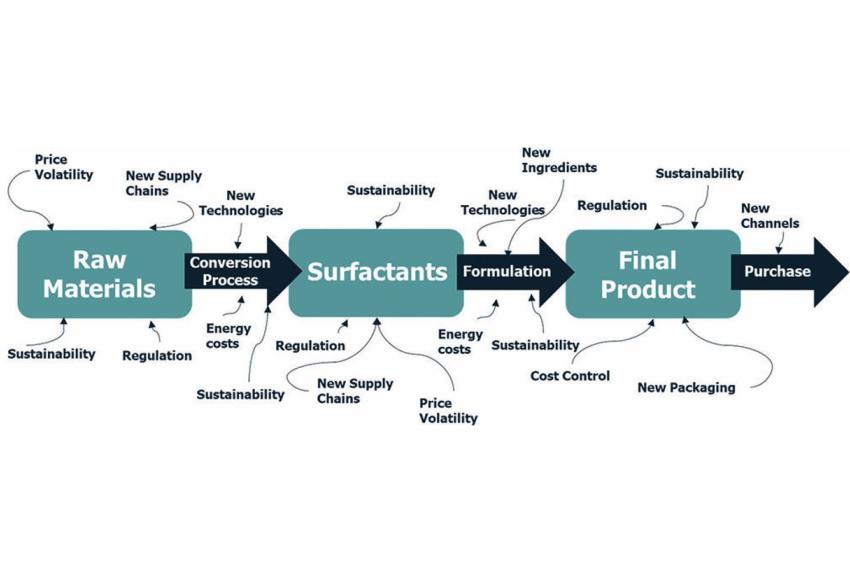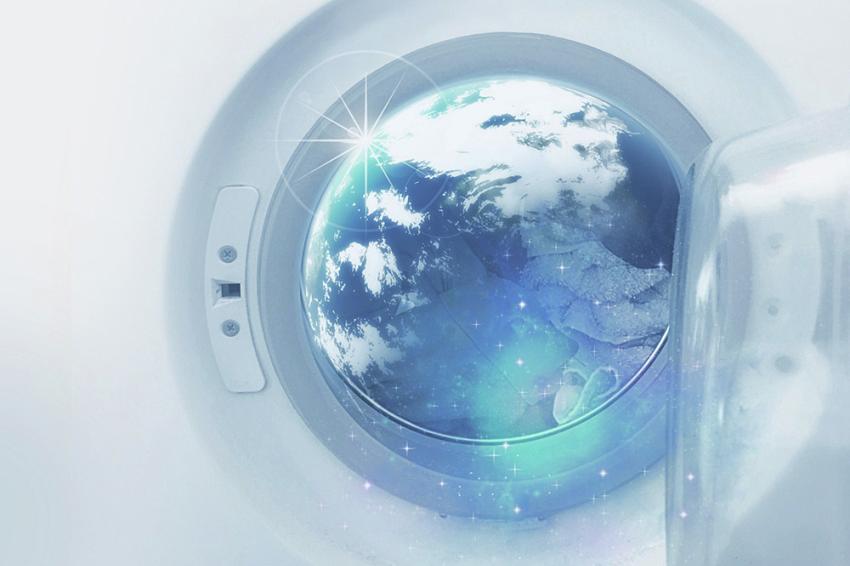Exploring Mega Trends and Value Chain Complexity with Cepsa Chemicals
Sustainable Surfactant Solutions
Companies are increasingly seeking innovative and sustainable solutions as the sector navigates the complexities of the value chain and responds to prevailing megatrends. With a legacy spanning almost 95 years, CEPSA has emerged as a global player in the energy and chemical sectors. Formerly known as Compañía Española de Petróleos, the chemicals branch of the company is now moving towards a more sustainable chemistry, not by ignoring its fossil-based roots but by adding raw materials of renewable and circular origin. Christene Smith sat down with Juliana Pantalena, Global Marketing Head for Surfactants at CEPSA Chemicals, to discuss the impact of megatrends and value chain challenges on the business and the company’s sustainable product developments.
CHEManager: What are the current megatrends in the surfactants industry, and how do they impact the global market?
Juliana Pantalena: Within the Home Care segment, manufacturers are seeking new formulations and more sustainable, effective, and suitable products. In Personal Care, consumers are changing behavior towards a more conscious consumption regarding environmental, ethical, and social impact. Various trends are driving the market:
- Regional growth: emerging countries, increasing population, income development, urbanization, and consumers´ rising sophistication are the main levers of this trend.
- Convenience: multipurpose detergents and changes in cleaning technology — fast wash cycles, autodosis washing machines, etc. — are factors shaping consumption.
- Compact formats: active reductions for the same performance at a smaller dose benefiting the environment due to the reduced CO2 footprint, reduction of inner space, and saving in transport costs.
- Hygiene: increased hygiene concerns as consumers look to maintain a safe environment.
- Regulatory trends: regulatory agencies are reviewing and defining new parameters on the products that are used for home and personal care formulations.
- Sustainability: from raw materials to finished products, manufacturing, packaging, transportation, and usage by the final clients. The sustainability trend focuses on reducing packaging to reduce the amount of plastic and sustainable ingredients – plant-based products — targeting CO2 reduction emissions to the atmosphere.
- X-free: informed consumers are forcing brands to use alternative ingredients to produce “chemical-free” products — sulfate-free, gluten-free, cruelty-free.
How does CEPSA stay ahead of evolving consumer preferences and requirements to deliver surfactant solutions that meet industry needs?
J. Pantalena: In the surfactant business, we are committed to research, development, and innovation to guarantee the sustainability of our industry and the quality of our products and providing technical services.
More than 175 detergent formulations were evaluated to improve the detergent’s compaction and performance, and more than 500 assays were done and 3.000 hours per year were invested in adapting our products to the challenges of today´s detergent formulations. Our research center is equipped with the newest technologies, including analytical support and pilot plants, and is based on four main pillars. 1) Characterization and quality control to ensure full support to the technical and formulation requirements of the sector. 2) Evaluation and performance of surfactant´s properties and new products — foam, soil removal, rheology profiles, stability, etc.. 3) Technological radar to explore alternatives to offer more sustainable and innovative products, improving their performance and sustainability. 4) Customer support to develop and improve different types of home and personal care formulations.
How is the surfactants value chain evolving, and what specific complexities do you address in this regard?
J. Pantalena: The surfactants value chain is complex and affected by many trends and challenges. At CEPSA Chemicals, we are trying to transform all these uncertainties into opportunities. This is only possible by leading from the front. As market leaders in the linear alkylbenzene — LAB — business, we are actively partnering with customers and industry to shape the direction of the sustainability dialog within its core business segments.
“I believe that the surfactants industry is the link between nature and its offerings,
by using sustainable chemistry, following all guidelines, bringing innovation,
and meeting customers’ demands to help create better products and a better world.”
We are involved in all steps of the value chain, from the definition and selection of raw materials to the surfactant production and understanding and support on the development of final formulations with our customers to the end user consumers. I believe that the surfactants industry is the link between nature and its offerings, by using sustainable chemistry, following all guidelines, bringing innovation, and meeting customers’ demands to help create better products. That is not an easy task, there are many key impacts that the surfactant industry needs to be aware of and comply with. (Editor’s note: cf. figure 1).
You mentioned the LAB business. How does this new sustainable linear alkylbenzene fit into CEPSA’s sustainability roadmap?
J. Pantalena: LAB is an essential ingredient in the manufacture of biodegradable detergents. Now, with NextLab, we seek to maintain our leadership position in sustainable LAB. We are co-owners of the best manufacturing technology available on the market and are leaders in its industrial implementation with our Detal project at the Puente Mayorga chemical plant. We have completed the transformation of our chemical plant, which allows us to increase LAB production with a safer, more efficient, and sustainable process. NextLab will lead the industry’s transformation and help customers achieve their sustainability goals and produce detergents with a reduced carbon footprint and based on alternative raw materials while keeping the exact specifications and performance.
How do you ensure regulatory compliance while maintaining product quality and competitiveness?
J. Pantalena: Our environmental management system allows us to progress in complying with applicable legislation and our environmental policies to transparently reduce the impact of our activities, aligning ourselves with our stakeholders’ expectations. Collaborations are vital for adapting to this new regulatory environment. Thus, we work closely with clients, competitors, and associations like CESIO, CLER, etc.
CEPSA Chemicals’s NextLab R product complies with the certification system ISCC PLUS. that covers all agricultural and forestry raw materials, waste and residues, non-bio renewables, and recycled carbon materials and fuels.
Recently we also obtained The Roundtable on Sustainable Palm Oil (RSPO) certificate. Technological innovation allows us to maintain product quality and competitiveness while ensuring regulatory compliance.
How do you assess the EU Green Deal and the EU’s Chemicals Strategy for Sustainability? Do these programs set the right goals and sketch realistic pathways to reach them?
J. Pantalena: In CEPSA we are implementing a sustainability strategy for decarbonization and defossilization of our portfolio that aligns with the goal of EU´s Green Deal. Our approach comprises the entire supply chain, from sustainable sourcing to production processes. We prioritize the development and adoption of safer technologies while promoting the principles of the circular economy to minimize waste generation and resource consumption. The recent retrofitting of our factory at San Roque, Spain, from HF to Detal technology and the production of Next-Lab are proof of our commitment. Furthermore, our company is fully committed to carbon neutrality and has set ambitious targets to reduce the carbon footprint associated to our activities and products.
“We prioritize the development and adoption of safer technologies while promoting the principles of the circular economy
to minimize waste generation and resource consumption.”
While we recognize the challenges ahead, our stakeholders share our vision and support our plan to not only drive positive environmental impact but also provide a more resilient and competitive future for our company and the industry as a whole.
With respect to the Chemical Strategy for Sustainability, the pathway must follow science-based methodologies and avoid overregulation.
How do you incorporate sustainability principles into surfactants production and value chain? With the rising demand for biobased and natural surfactants, how is CEPSA developing sustainable alternatives?
J. Pantalena: CEPSA is following the path set by the UN. Thus, we are committed to the sustainable development goals — SDGs. Regarding our product offering, we have a well-balanced portfolio of surfactants, such as SLES, SLS, and AE, and LAB/LABSA as intermediates to produce LAS. Now we are transforming the LAB business with our Next-Lab family of products, It has the same properties and outstanding performance as traditional linear alkylbenzene — excellent washing performance, flexibility, processability, and good compatibility with other ingredients — while having a reduced carbon footprint compared to its counterpart.
“We are committed to climate change and support the transition to a circular economy
that optimizes the use of resources to build a more sustainable, efficient,
and fair world dedicated to supporting customers, partners, and associations.”
You said that collaborations are vital. Could you give an example?
J. Pantalena: Sinarmas CEPSA is such an example. It is a joint venture bet-ween CEPSA Chemicals and Golden Agri Resources — GAR. GAR offers an extensive portfolio of fatty acids, fatty alcohols, glycerin, and soap needles manufactured using stringent quality control processes. A global leader in palm oil production, GAR is producing more than 2.4 million tons of crude palm oil annually. It manages about 538,000 hectares of plantations, including smallholder farms across Indonesia and achieved 98% traceability to plantation of its palm supply chain at the end of 2022. As a result, Sinarmas CEPSA can offer a uniquely integrated business model in the oleochemical industry, which integrates activities “from tree to customer” with best industry practices and the most stringent sustainability policies.
Looking to the future, what opportunities and challenges do you foresee for the surfactants industry, and how are you preparing to capitalize on them while addressing associated challenges?
J. Pantalena: We are driving the shift towards sustainable chemistry. We are committed to climate change and support the transition to a circular economy that optimizes the use of resources to build a more sustainable, efficient, and fair world dedicated to supporting customers, partners, and associations.
CEPSA is working to stay ahead of industry challenges and consumer social and environmental awareness. Soapers are launching new plant-based products with alternative ingredients. Furthermore, alternative packaging with a reduced amount of plastic is being released by many companies, especially in developed regions. Convenience and sustainability are driving a shift in product formats with more concentrated formulas.
In terms of opportunities, a growing population in developing markets will help to increase the demand. The growth of the middle-class, hygiene consciousness, urbanization, and washing machine possession rates will also contribute to higher demand. CEPSA Chemicals is preparing to capitalize on them by focusing on innovation and sustainability. We have undertaken several innovation projects to develop new products, identifying biobased alternatives to fossil-based products and seeking more sustainable schemes.







